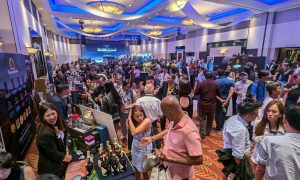George Town is changing so fast that it’s hard to keep up with the new boutique hotels that are opening here at the moment. Ryokan, a backpacker’s hostel with the finish of a five star hotel, recently opened in Muntri Street, and the Boutique Residence recreates a corner of Switzerland in Jalan Masjid Kapitan Keling. Its splendidly re-furbished double storey rooms cluster around a central courtyard and indoor swimming pool. By contrast, the Penaga, on the corner of Hutton and Transfer streets, constructed out of a row of art deco townhouses, interprets heritage in a creative and inclusive way, using recycled antiques from China. And Chris Ong’s new Muntri Mews and Clove Hall have set the standard for a dignified restoration of the past, brought comfortably and elegantly up to date.
But no city can survive on crumbs from tourists alone. George Town has historically been a place of artisans and merchants. Traditional arts, such as rattan weavers, silk lantern makers, Qu’ran calligraphers and printers, spice grinders, joss stick makers, wood carvers and shoe makers, flourished here. But many of the practitioners are getting old now, and fewer young people are interested to learn these crafts. And yet the vibrancy of these arts adds immeasurably to the richness of the terraced streets. Without this mix of trade and tourism, George Town could run the risk of becoming a sterile ‘theme park’, paying homage to a culture no longer alive.
From its inception, Penang has been a place to do business and has always welcomed foreign migrants who came to seek their fortune. Spices, opium and cloth have all been traded here. Francis Light, the founder of George Town, planned the first streets as a ‘mosaic of ethnic quarters’ and this pluralistic approach has persisted into the 21st century. Indian warehouses, Chinese shops and Muslim businesses, with their accompanying cultural manifestations of temples, clan houses and mosques all co-exist happily. In one corner of Armenian Street, for instance, Amelie, a delightful miniature coffee house rubs shoulders one side with a Nonya beaded shoe workshop and on the other with an inviting passage way to a clan house and temple. The architectural features of the shophouse, are as diverse and yet harmonious as its residents. The basic design is perhaps Chinese, particularly the series of open courtyards, and fan-shaped air vents. The Malays brought their expertise in wood carving and fretwork, the Indians their skilled construction techniques and recipe for durable plaster, the Europeans their French windows, louvered shutters and decorative stucco.
Shophouses are designed to extend backwards from the street some thirty metres. Some are even longer than that. They were designed as highly practical working/living spaces and in the past performed multiple functions such as shops, cafes, godowns, workshops, residences, stables and animals yards. The narrow frontages, often no more than six or seven metres wide, give onto a covered ‘five foot’ ways, or kaki lima, often exquisitely tiled, making it possible to walk down the street protected from both sun and tropical rain. Nowadays, many owners have ‘annexed’ their five foot ways, turning them into terraced sitting areas, or even, less aesthetically, parking spaces for motor bikes.
The downstairs front room, giving onto the street, was where business was carried out. A carved screen protected the rooms behind. Lit by the central wells, these were more private family spaces, such as ‘dining halls’, kitchens and bedrooms. As they were designed with ‘through drafts’, open grilles which encouraged air to circulate, they were surprisingly cool and environmentally friendly buildings. Unfortunately the glazing needed to contain air-conditioning which most modern residents have installed has destroyed this green aspect of the shophouse.
Sandie Lenton, who bought a shophouse in Armenian Street three years ago and has used it as the base for her business, Penang Design, recently converted it into her home. She says that shophouses are remarkably flexible spaces which lend themselves to a variety of uses. Her property is next to an abandoned house, open to the sky and boarded up on one side. There’s a swiftlet property a few doors down, a house in which birds are reared. Their spittle will ultimately create the delicacy bird’s nest soup but they are often not considered very desirable as neighbours. A chi-chi cheongsam maker has recently moved in, but there is still an old time barber and basket weaver in the same row of shophouses.
Round the corner from Armenian Street, the team from Bon Ton in Langkawi, Narelle McMurtrie and Alison Fraser, have recently opened China House. They have renovated three interlinked shophouses stretching between Beach Street and Victoria Street with wonderful panache. China House is a café and an art gallery, a private dining space and wine room, but also has space for a pop up shop, a large conference room and other rooms which can be used for varied purposes.
George Town is poised to become an imaginative, edgy city if creative people can be encouraged to make it their base. The flexible and trusty shophouse, renovated for contemporary needs, could continue to provide a great working and living space for cultural arts. As well as chic hotels and gorgeous cafes, George Town needs to protect some of its more traditional artisans and merchants while encouraging new creative industries to flourish there. Beyond that, the city needs to encourage novel solutions to urban issues and to promote true diversity. Let’s hope that when all the shophouses have been ‘done up’ that there will still be visual surprises in these beautiful streets and individual quirkinesses which both respect the past and look forward confidently to the future.
Source: The Expat December 2011
This article has been edited for ExpatGomalaysia.com
Get your free subscription and free delivery of The Expat Magazine.
"ExpatGo welcomes and encourages comments, input, and divergent opinions. However, we kindly request that you use suitable language in your comments, and refrain from any sort of personal attack, hate speech, or disparaging rhetoric. Comments not in line with this are subject to removal from the site. "



















